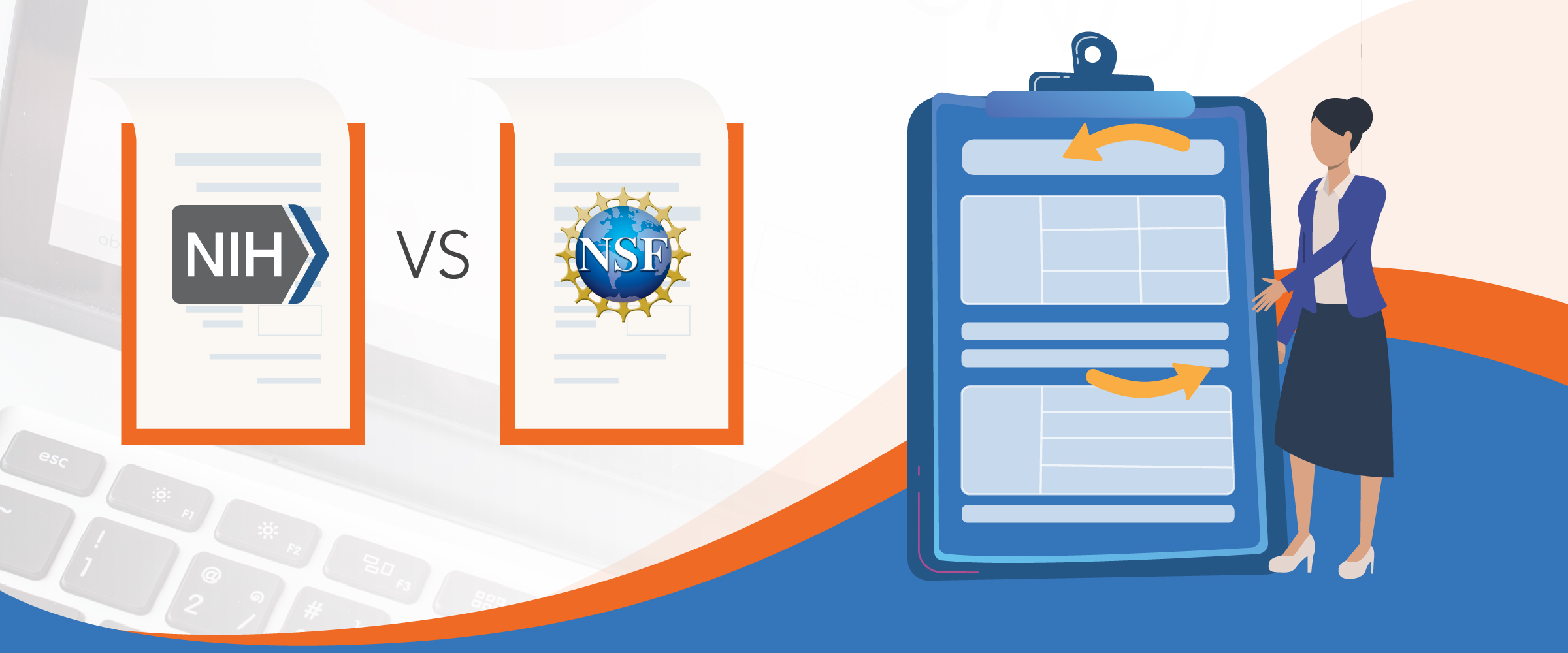
When it comes to funding research and programs, all sponsor agencies have unique missions. This uniqueness extends to their funding mechanisms, programmatic requirements, and merit review criteria. Additionally, each sponsor conducts business in their own way. Because of this, when applying for funding, you’ll find that the strategies and approaches to take can be very different, depending on the sponsor. Since this is such a huge topic, we’re choosing to focus on NIH vs NSF grant applications here.
This article will be useful for anyone who regularly applies for funding opportunities. It will also prove valuable for those new to the field of research administration. Let’s jump in.
NIH
The National Institutes of Health (NIH) is the primary U.S. federal biomedical and public health research funder. The mission of NIH is to enhance health, lengthen life, and reduce illness and disability. They comprise 27 Institutes and Centers (ICs), each with a research focus and congressional budget.
Funding Announcements
NIH advertises funding support through notices of funding opportunities or NOFOs. Like the different ICs, every NOFO is unique and contains the instructions for preparing and submitting a funding application to the appropriate IC. Investigators should carefully follow the NIH application guide and NOFO when preparing a funding application.
Typical Proposal Components
Because NIH has a public health service mission, investigators must communicate the project’s public health relevance in a 2-3 sentence Project Narrative.
Specific Aims are the most vital part of any NIH application. Specific aims outline project objectives and the key steps to fulfill the objectives. Two to four independent aims are generally ideal, depending on the proposed study’s duration (typically 3-5 years). Too many and the investigator risks not completing the study. Too few and the project may not be significant and impactful.
NIH projects are typically 3-5 years, with direct cost requests as high as $500,000 per year depending on the solicitation. Investigators should make smaller requests ($250K or less) in increments of $25,000. This modular budget format allows investigators and NIH to streamline requests and award management.
Just-in-Time (JIT) Procedures
Specific NIH programs allow proposal elements to be submitted later in the application process. These Just-In-Time requests relieve investigator and administrative burdens of preparing materials that do not factor into the review process. However, these materials are crucial for award initiation. Examples of JIT requests include Other Support documents, compliance certifications for using humans and animals in research, and other certifications and disclosures. If an award is pending, investigators must be responsive to these requests.
Review Criteria
NIH peer reviewers evaluate proposals on five criteria. These criteria determine the proposed work’s scientific and technical merits. NIH makes funding decisions based on these and additional criteria. Therefore, investigators must address these criteria in every application.
| NIH Review Criteria | Purpose |
| Significance | Demonstrates the importance of the proposed research in the context of current scientific challenges |
| Investigators | Details the background, training, and expertise to conduct the proposed work |
| Innovation | Describes novel concepts, methods, or technologies used to impact the project |
| Approach | Demonstrates the scientific quality of the proposed work that is reproducible and feasible |
| Environment | Describes institutional and other resources appropriate to successful project execution |
Successful applicants understand the NIH Grants process. Applicants are encouraged to discuss their ideas with an NIH program official before submission. The program official can answer programmatic questions and tell an investigator if their research falls within the scope of the funding opportunity or particular IC.
NIH References
- More on NIH scoring and funding determinations
- Learn about NIH Grants & Funding
- Detailed and modular budget guidance
- A description of Just-in-Time Procedures
NSF
The National Science Foundation (NSF) is an independent agency of the U.S. federal government that supports fundamental research and education in science, technology, engineering, and mathematics. Its mission is to promote the progress of science; to advance national health, prosperity, and welfare; and to secure the national defense. NSF is organized into Directorates and Offices, with each Directorate overseeing a specific discipline.
Funding Announcements
NSF advertises funding through program descriptions (PDs), program announcements (PAs), Broad Agency Announcements (BAAs), and solicitations. Applicants responding to solicitations should be prepared to respond quickly, as solicitations typically only last for a limited period.
Typical Proposal Components
Applicants should carefully follow the NSF Proposal & Award Policies & Procedures Guide (PAPPG) and the funding notice when preparing an application. Research proposals to the NSF generally follow the same format, including:
- Project Summary
- Project Description
- References Cited
- Required documents for senior personnel
- Proposal budget and justification
- Facilities, Equipment, and Other Resources
- Additional plans and documentation, depending on the project
The Project Summary overviews the proposed activities and addresses NSF’s two review criteria: Intellectual Merit and Broader Impacts. Investigators must address the review criteria in the 15-page Project Description that details the project’s why, what, and how.
Investigators demonstrate how they and their team are uniquely situated to conduct the proposed work in the required documents for senior personnel. These documents are the Biographical Sketch and the Current & Pending Support documents. Institutional and other resources necessary to carry out the planned work are detailed in the Facilities, Equipment, and Other Resources document.
Budgeting & Data Management
NSF requires a detailed budget and budget justification. Investigators should be aware that NSF does not allow cost-sharing unless specifically required by a program. NSF project durations are usually 1-3 years, with median budgets ranging from $95,000 to $190,000 depending on the NSF Directorate.
NSF also requires a 2-page Data Management Plan on how an investigator will share research results. Depending on the proposed project, investigators may need to include additional documents, such as a post-doctoral mentoring plan.
Review Criteria
NSF funds projects of the highest quality and those with the potential to advance knowledge. NSF reviewers score proposals on how well they address intellectual merit and broader impacts. While both criteria are essential, investigators should address how their project has the potential to benefit society. NSF Division Directors make funding decisions based on proposal scores and how aggregate projects can work synergistically to achieve societal goals.
| NSF Review Criteria | Purpose |
| Intellectual Merit | Demonstrates the potential to advance knowledge |
| Broader Impacts | Demonstrates how the project benefits society |
To be successful, applicants should understand the NSF proposal and award process and how funding decisions are made. Investigators should consult the NSF Program Officer listed in the funding announcement before applying. Program officers are expert researchers who guide proposals through the merit review process and recommend funding to Division Directors.
NSF References
- Added details about funding at NSF
- A description of the NSF Merit Review process
- More about Broader Impacts
Conclusion
Even for veteran research administration teams, it can be difficult to navigate the complex requirements of funding sponsors. This is true when pursuing NSF vs NIH grant applications, for example. Throughout the application process, each agency has considerations that are unique and specific at every step of the way. Additionally, the requirements can change over time, making the process even more complicated.
Fortunately, the right eRA software can help untangle the challenges, leading to more effective and productive teams. This can result in better proposal development, higher win rates, and ultimately more funding. Let’s talk about how our Streamlyne Research software can make your team the best it can be. Please reach out to us to connect with a friendly and knowledgeable product expert.

